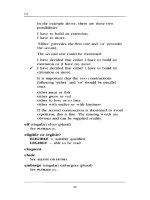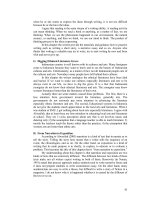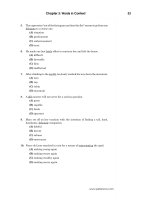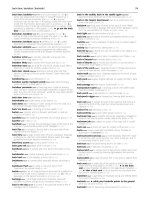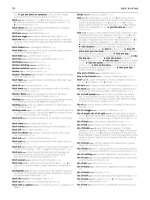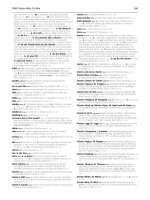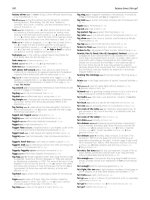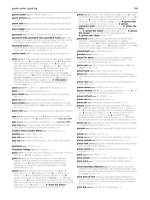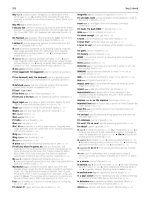POLICE ENGLISH - PART 7 potx
Bạn đang xem bản rút gọn của tài liệu. Xem và tải ngay bản đầy đủ của tài liệu tại đây (240.35 KB, 10 trang )
Professional English for International Communication (Police)
Haapsalu 2003
Timing
Timing is another issue which we have not addressed as it depends on the students and
your context. Again, look through the material and decide how you want to use it.
'Copyright Free'
The materials are 'Copyright Free' and may be freely copied and used in their original
form, as long as the 'Copyright Free' label and credit to the Haapsalu Writing Team are
clearly seen.
Tallinn, Estonia 7
th
June 2003
PDF created with pdfFactory Pro trial version www.pdffactory.com
Presentations
________________________________________________________________
Copyright FreeHaapsalu Writing Team
A: Find someone who
Name
has listened to a presentation recently.
is confident when they deliver a presentation.
has delivered a presentation recently.
is unfamiliar with presentation skills.
is embarrassed when they speak in public.
B:Getting started: What makes a good presentation? Discuss in groups.
C:Stages: What are the different stages of a presentation?
D: Below you will find two alternative ways of expressing yourself
appropriately in a presentation. One is formal, and the other is less formal.
Work in pairs to place the expressions into the correct categories. Can you
add to them?
Introduction:
Good morning, Ladies and Gentlemen; Morning everyone; My name is ; I!m responsible for ; I
want to tell you about ; I!m ; If you have any questions, I!ll be happy to answer them.
Formal Less formal
Main Part:
Finally; First of all; I!d like to look at ; That brings me to the last point which is ; As you know ;
Now let!s move on to the question of ; Moving on quickly to ;
Formal Less formal
Conclusion:
In conclusion let me briefly summarise the main points; I think that!s everything; That!s all for now;
Formal Less formal
Questions:
Any questions Could you be more specific? Do you have any questions? You!ve raised an
important point there; I!ll get back to you at the end of the presentation if you don!t mind. Do you
agree?
Formal Less formal
E: Prepare the introduction of a presentation.
PDF created with pdfFactory Pro trial version www.pdffactory.com
Presentations
________________________________________________________________
Copyright FreeHaapsalu Writing Team
Teacher s Notes
Summary: To provide a framework for the duration of the course with regard to
effective presentation skills.
Preparation: Photocopy text (one copy per student) " supplementary materials;
make sets for 4/5 groups of stages of presentation " cut and laminate if possible
Procedure:
1) Ss circulate and ask questions to as many other members of the group as
possible. The objective is to #find someone who ! and to get a different
name in each box. Refer Ss to the instructions for section A. Short
discussion at teacher!s discretion.
2) Ask Ss what makes a good presentation. This could be in the form of a
whole class debate or in small groups. At this stage, do not be judgmental.
3) Now tell Ss that you are going to give them some advice written by an
expert. Ask them to read the text carefully. The text has been written to
describe how not to do it, but do not tell the Ss this. Let them discover it.
Hopefully a bright student will question the content early on.
4) Hold short feedback slot. What is the class opinion of the advice?
5) Ss work in groups. Give out OHT!s and pens (if possible). Groups make a
list of good advice based on the text (ie the opposite). One member of
each group talks the Ss through their ideas in front of the class. Hold short
feedback slot and give out copies of reference sheet (supps)
6) Refer to instructions for section C.Ask Ss what the different stages of a
presentation are.
7) Give out sets of cut-up stages to each group. Ss put stages in order.
Suggested order: greeting, your name, your position, reference to
audience, topic, brief overview, timing, when to ask questions, first item on
agenda, next item, final item on agenda, conclusion, summary, thanking
the audience. Note " questions and personal input are subjective and
open to discussion.
8) Refer to instructions for section D. Ss complete tables.
9)Ss prepare the introduction to a presentation (greeting " when to ask
questions)
PDF created with pdfFactory Pro trial version www.pdffactory.com
Presentations
________________________________________________________________
Copyright FreeHaapsalu Writing Team
Teacher s Notes ! supplementary materials
Text for section B ! one for each group
What makes a good presentation?
Make sure you don!t get up too early on the morning of your presentation. The
evening before will have been busy, having dinner and drinks with people, so you
need as much time as possible in bed to compose your thoughts. Don!t worry
about checking your equipment. Someone less important will be doing this for
you.
Your audience is interested in you, so make sure you tell them about all your
accomplishments during the introduction. It doesn!t matter if you haven!t
prepared the first minute. After all, they are here to listen to you " the expert " so
anything goes at the beginning.
Don!t simplify your presentation too much. Show your superior intelligence by
using long words, expressions and jargon. It is of no consequence if you pause
or mumble " all the best university lecturers speak in this way. Your audience will
be hanging on to your every word anyway.
Remember that humour is important, so you should prepare a few jokes.
Anticipate much laughter " pause for applause! This will compensate for your
lack of visual aids.
Last of all, make sure you have planned your exit strategy. The last thing you
want is to have to answer questions from people who will never truly understand
your point of view.
PDF created with pdfFactory Pro trial version www.pdffactory.com
Presentations
________________________________________________________________
Copyright FreeHaapsalu Writing Team
Teacher s Notes ! supplementary materials
Mark Powell's excellent book 'Presenting in English' (ISBN 1899396306) has
a list of tips extracted below. The book contains explanations of these
points and lots more.
How to become a good presenter
1) Leave nothing to chance
2) Know exactly how to start
3) Get straight to the point
4) Talk to your audience
5) Know what works
6) Remember the 4 C!s " be clear, concise, calm and confident
7) Speak naturally
8) Know your audience
9) Treat your audience as equals
10)Be yourself
11)Take your time
12)Don!t make a special effort to be funny
13)Let your visual aids speak for themselves
14)Never compete with your visuals
15)Develop your own style
16)Enjoy the experience
17)Welcome questions from your audience
18)Finish strongly
PDF created with pdfFactory Pro trial version www.pdffactory.com
Presentations
________________________________________________________________
Copyright FreeHaapsalu Writing Team
Teacher s Notes ! supplementary materials
Cards for section C
Greeting Your name
Your position Reference to audience
Topic Brief overview
Timing When to ask questions
First point Next point
Final point Conclusion
Summary Thanking the audience
Questions Personal input/hook
PDF created with pdfFactory Pro trial version www.pdffactory.com
Imprisonment and Early Release
___________________________________________________________________________________________________
__________________________________________________________________
Copyright Free Haapsalu Writing Team 2003
Governments consider prisons the main form of punishment available to the criminal
justice system. But is the system as effective it is supposed to be?
One objectives of imprisonment is to rehabilitate offenders, to correct their attitudes and
anti-social behaviour. The second important aspect is to provide public safety by isolating
them. It also functions as a warning to the rest of the society to deter others from
committing crimes.
On the one hand the system satisfies society and victims' need for retribution. On the other
hand this leads to further problems because the victims are interested in longer prison
terms. This makes prisons overcrowded and consumes more and more tax-payers'
money.
Research carried out in America shows that prisoners serve only a fraction of their
sentences
Average sentence for murder was 15 years imprisonment, but the actually served was
5,5 years.
The figures for rape were 8 years in prison and 3 years served.
To avoid prisons being overcrowded and to relieve the tax payers burden Great Britain
introduced a system of electronic tagging. Apart from being expensive it also turned out to
be ineffective as these figures show:
1,638 crimes have been committed by prisoners who would have otherwise been in jail
since the tagging scheme began in 1999.
The crime spree includes 229 violent offences, 6 sex crimes and more than 500 cases
of theft and fraud.
Under the home detention curfew scheme, which was introduced to ease overcrowding in
jails, about 3000 prisoners a year are allowed to serve out the last 3 months of their
sentences at home under electronic surveillance. Many prisoners simply took off their tags
and were 'unlawfully at large'.
PDF created with pdfFactory Pro trial version www.pdffactory.com
Imprisonment and Early Release
___________________________________________________________________________________________________
__________________________________________________________________
Copyright Free Haapsalu Writing Team 2003
APut the jumbled words into the five categories below.
steal theft burglar minor
confess slammer burgle manslaughter
battery nterrogate abusive arsonist
assassin penitentiary rapist detention centre
prison money laundering jail hijacker
violenthired serious fraud batter
Crimes Criminals
Custodial
institutions
Crime related
verbs
Crime related
adjectives
BWhat is the difference between the following words?
1. prisonjail
2. murdermanslaughterassassination
3. murderhomicide
4. burglarytheft
CDiscuss first in pairs and then as a class why all prisoners can't be released
onparole.
DDiscussion.
Work in two groups. One group prepares arguments in support of short time prison
sentences. The other group prepares arguments for long term sentences.
When you are finished work in pairs with a partner form the other group. Take turns to
present your group's arguments as your partner tries to interrupt you using the expressions
below and vice versa.
Sorry, but May I explain my point
Excuse me, I totally disagree with you
If you don't mind, I would like to mention . With respect
I see your point, but You are completely mistaken
PDF created with pdfFactory Pro trial version www.pdffactory.com
Imprisonment and Early Release
___________________________________________________________________________________________________
__________________________________________________________________
Copyright Free Haapsalu Writing Team 2003
Teacher's notes.
Procedure:
1.Ask Ss:
If they have ever been in prison
What they would lack most while in prison
To describe a perfect cell,
What would cause more discomfort while in prison- physical or mental environment
What their attitude to prisons and sentencing is
2. Ss read the text. Discuss reactions to text.
3. Students do vocabulary exercise putting jumbled words into the five categories.
Key
Crimes - battery, manslaughter, fraud, money laundering, theft
Criminals - hijacker, rapist, burglar, assassin, arsonist
Custodial institutions - prison, jail, detention centre, slammer, penitentiary
Crime related verbs - interrogate, confess, steal, burgle, batter
Crime related adjectives - hired, violent, abusive, minor, serious
4. Ask Ss to find the difference between the words.
Key
Prison - an institution of maximum security
Jail - an institution of medium security
Murder - killing somebody intentionally
Manslaughter - accidental killing
Assassination - killing for political reasons or for money
Murder - BrE
Homicide - AmE
Burglary - going into a building by force to steal
Theft - taking somebody's property
5. Ask Ss to discuss first in pairs and then as a class why all prisoners can't be released
on parole. As a support use the box on the worksheet.
6. Discussion
One group has to support short time prison sentences, while the other group supports long term
sentences. Then divide Ss in pairs. One presents their team's arguments while their partner tries to
interrupt him using the expressions from the worksheet.
7. Homework.
Ask the students to imagine themselves in the shoes of a prison director. Write a formal
letter to the Ministry of Justice explaining the prison!s needs and supporting them with
arguments to get the money.
or
Ask the students to write a letter to the Minister of Justice complaining about short
sentences and early release of prisoners.
PDF created with pdfFactory Pro trial version www.pdffactory.com
The Prosecution Process
________________________________________________________________
Copyright FreeHaapsalu Writing Team
A: Linking words join one idea to another and help the reader see how your
report is organised. Read this report about the CJS in England and Wales
and underline linking words or phrases as you go e.g. firstly.
1. Introduction
This report describes the prosecution process in the Criminal Justice System in
England and Scotland.
2. The Prosecution Process
Figure 1.2 shows the whole process from the time the crime is reported to the
successful prosecution of the criminal.
2.1 The Crime
Firstly the police either issue a caution or charge the suspect, depending on the
seriousness of the crime. Assuming the crime warrants further investigation, the
case will typically proceed to the Crown Prosecution Service.
2.2 CPS
After that, it is the responsibility of the CPS to decide if it is necessary to proceed
with the prosecution. Two factors must be considered is it !in the public interest"
to continue and is there enough evidence? For example victims of rape are often
unwilling to testify and hence the case will be dropped.
2.3 Magistrate s Court Hearing
The final hearing is in the magistrate"s court. Magistrates are actually lay-people
who listen to opposing presentations of the case and decide on the seriousness
of the offence. However the Court Clerk advises on legal questions. A serious
offence will automatically go to the Crown Court while a minor crime can be tried
in a magistrate"s court.
2.4 Triable-either-way offences
For some offences the accused can choose trial by jury. Often these cases get to
the first day in the Crown Court but the accused change their plea from not guilty
to guilty as a result, wasting time and money.
2.5 Trial
The trial is a criminal or civil court case heard before a judge. Obviously, if the
accused is found guilty, they are free to go home. If found not guilty, a legal
punishment will be given by the court in the form of a sentence. The jury decides
if the person is guilty or not guilty based on evidence heard in court while the
judge decides upon the sentence.
PDF created with pdfFactory Pro trial version www.pdffactory.com
